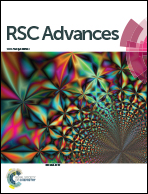Macroporous network Li3V2(PO4)3/C cathode material with excellent high-rate performance for lithium-ion batteries
Abstract
Macroporous network Li3V2(PO4)3/C was successfully synthesized by rheological phase method using ethanol and 1,2-propylene glycol as a mixed solvent. At the same time, Li3V2(PO4)3/C via a single ethanol solvent was prepared for comparison. XRD analysis of the two samples confirmed the formation of high purity and well-crystallized Li3V2(PO4)3/C. The SEM results reveal that there is a significant difference in morphologies between the two samples, the one by single ethanol shows a flake-like morphology, while the other one presents a macroporous network morphology. The sample with a macroporous network morphology shows discharge capacities of 154, 138, 130, 120, 101, 93, 83 and 70 mA h g−1 at 1C, 3C, 5C, 10C, 20C, 30C, 40C and 50C (1C = 150 mA g−1) in the voltage range of 3.0–4.8 V, respectively, which are better than those of the Li3V2(PO4)3/C sample with a flake-like morphology. In summary, it is demonstrated that the Li3V2(PO4)3/C cathode material using a mixed solvent can deliver a significantly improved high rate performance in the voltage range of 3.0–4.8 V, which can be mainly ascribed to the macroporous network morphology.


 Please wait while we load your content...
Please wait while we load your content...